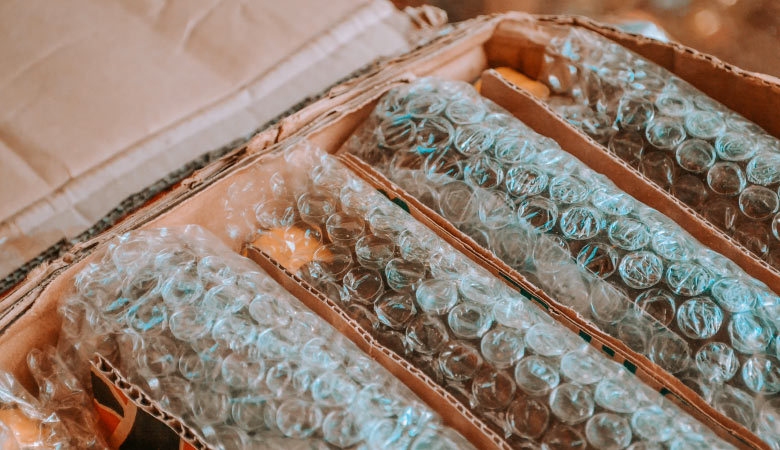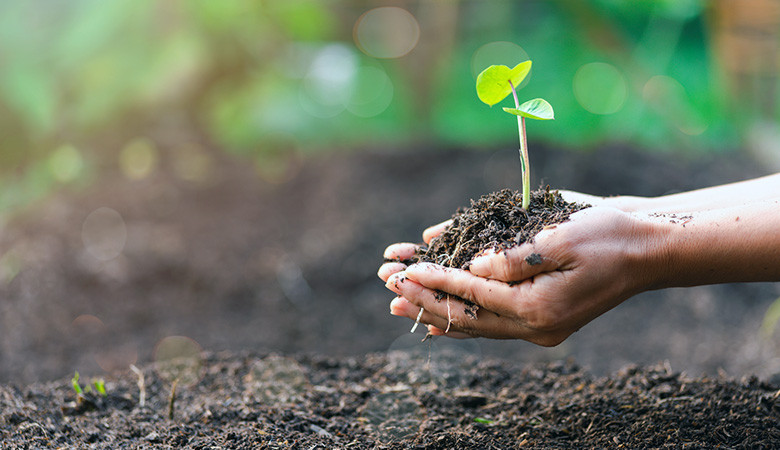Durabilité / Articles
Emballages durables : 5 manière de rendre le packaging plus respectueux de l’environnement
La production de plastiques ne cesse d’augmenter, au détriment de l’environnement et des entreprises. Heureusement, il existe des manières de passer aux emballages durables.

 12 minutes de lecture
12 minutes de lecture
2022-07-14 14:04:10
Les emballages durables sont l’allié indispensable des entreprises qui placent la durabilité au cœur de leur activité et de celles qui cherchent des moyens pratiques de réduire les coûts, accroître la productivité des équipes et offrir une meilleure expérience à leurs clients. Découvrez quels sont les emballages durables et comment adopter un packaging plus respectueux de l’environnement.
Les emballages durables : quels sont-ils et quels sont leurs avantages ?
Les emballages durables sont produits à partir de matériaux recyclés et recyclables, ou à l’impact réduit sur l’environnement une fois supprimés. Ils ont recours à des processus de fabrication à conscience environnementale, afin d’éviter que les ressources de la planète ne s’épuisent pour les générations futures.
Il s’agit d’un thème urgent et d’une priorité mondiale. Mais bien qu’ayant été souvent débattu et médiatisé, les prévisions tendent encore vers une augmentation de la production des emballages plastique – selon certaines estimations, le pic de production ne sera atteint qu’en 2100. Si rien ne change, d’ici 2050, la production de ce type d’emballages va quadrupler.
Il est facile de comprendre la raison de ces estimations. Malgré les efforts, les emballages sont omniprésents dans notre quotidien ; pratiquement tous les produits que nous achetons ou consommons sont conditionnés dans des emballages protecteurs qui sont quasiment tous faits de plastique. La production de ce matériau atteint donc des proportions dramatiques. Ces dernières années, seule la pandémie de Covid-19 est parvenue à diminuer, bien que légèrement, une tendance à la hausse de plusieurs décennies. Il est donc primordial que la société repense ses habitudes de consommation et que l’industrie adopte des mesures visant à utiliser des emballages durables pour la mise à disposition de ses produits.
Quelques-unes des grandes marques mondiales ont déjà franchi d’importantes étapes en ce sens. Par exemple, L’Oréal a lancé, en 2013, un programme de durabilité intitulé « Sharing Beauty With All », dont l’objectif est de transformer ses emballages plastiques en emballages 100 % recyclables d’ici 2025. Le géant Carlsberg a également supprimé les anneaux de plastique qui entouraient les packs de canettes de bière, les remplaçant par l’application d’une colle recyclable, ce qui lui a permis d’afficher une réduction de 1200 tonnes de plastique par an.
Ces premières expériences ont présenté des bénéfices qui vont au-delà de la protection environnementale : elles ont permis de réduire les coûts de logistique, d’accélérer la chaîne de valeur et d’apporter de la valeur à leur image. Les consommateurs sont de plus en plus informés et conscients de la durée de vie utile des matériaux, tendant par conséquent plus à acheter des marques qui partagent ces valeurs. Ainsi, les entreprises responsables d’un point de vue environnemental créent, chez le public, un sentiment d’identification et sont donc perçues comme une source d’inspiration.
5 manières de rendre les emballages durables
Rendre les emballages plus durables peut représenter un défi pour les entreprises. Nous vous proposons donc 5 suggestions qui peuvent faire la différence.
1. Échanger le plastique contre des matériaux plus durables
Les emballages ne vivent pas que de plastique. En réalité, il existe plusieurs matériaux qui peuvent le remplacer, dont l’impact environnemental est minime, voire nul. Le verre, par exemple, est un matériau aux propriétés avantageuses qui peut être utilisé pour le conditionnement des aliments – il ne présente aucun risque de pollution et sa production n’utilise ni produits chimiques, ni additifs, le verre étant 100 % pur. La silicone a également remplacé le plastique traditionnellement utilisé dans les emballages et les ustensiles de cuisine, étant même plus sûr du point de vue alimentaire que le plastique.
D’autres matériaux tels que l’acier inoxydable, la bagasse, le bambou et le papier se sont révélés être des alternatives prometteuses dans la lutte contre le plastique. Revoir les processus d’emballage et chercher des manières d’intégrer des matériaux plus durables est donc une étape essentielle pour toute entreprise. Lorsqu’il n’est pas totalement possible de se passer du plastique, assurez-vous que les emballages sont 100 % recyclables, afin d’éviter qu’ils ne finissent dans des décharges ou fond des océans.
2. Définir des exigences d’emballage pour chaque type de produit
Il est possible de diminuer la quantité de matières premières nécessaires à la fabrication des emballages si ceux-ci ont juste la taille indispensable à un certain type de produit. Cela peut s’avérer plus pratique d’avoir un emballage unique pour tous les produits mais envisagez d’opter pour des emballages à tailles variables, prédécoupés, afin de s’adapter à leurs volumes.
De cette manière, non seulement vous réduirez les matières premières utilisées pour fabriquer l’emballage, mais vous aurez également besoin de moins de matériel de remplissage et de bande adhésive, les emballages étant plus compacts. Évaluez chaque type de produit et vérifiez les ajustements d’emballage possibles. Et pourquoi ne pas envisager de vous passer totalement d’emballage ? La tendance est connue sous le nom de « nude shopping » et, en Nouvelle-Zélande, une étude a démontré que les supermarchés ayant adopté cette logique dans la catégorie des produits frais ont augmenté les ventes de fruits et légumes de plus de 300 %. Renoncer aux plastiques à usage unique ouvre de nouvelles possibilités d’innover et de redessiner complètement l’expérience d’achat actuelle. Et il n’y a pas d’emballage plus durable que…celui qui n’existe pas.
3. Rendre les emballages plus créatifs et réutilisables
Et si les emballages n’étaient pas jetés après avoir été utilisés ? Cela signifierait un allongement considérable de leur durée de vie utile. Par exemple, un emballage peut contenir des instructions de découpe et de montage afin de le transformer en maison de poupées ou un jouet pour animaux.
La marque Samsung a adopté cette mesure dans son projet Eco-Package, en recyclant l’emballage de ses produits en des pièces utiles et décoratives pour la maison, telles qu’un tunnel pour chats, une bibliothèque pour livres, un porte-magazines ou une étagère.
Les emballages peuvent également avoir une seconde vie si la marque propose à ses clients de retourner les réceptacles résistants, pouvant même encourager ce comportement.
Un emballage peut également être conçu pour devenir un sac réutilisable ou un sac poubelle. Grâce à un design efficace, l’emballage peut même être recherché de manière proactive et partagé par le public.
4. Définir la méthode de lavage pour le matériel d’emballage
Les emballages sont souvent jetés car ils contiennent des substances adhérant à leurs parois internes et les rendant inutilisables. Ce scénario est fréquent dans les milieux hospitaliers ou tout autre aux besoins de désinfection spécifiques. Cependant, un lavage et une désinfection efficace peuvent résoudre ce problème et permettre le recyclage.
Si vous estimez que, dans votre entreprise ou votre secteur, vous pouvez réutiliser des emballages juste en ayant recours à l’hygiénisation, pensez à la Multiwasher Healthtech, une solution de lavage industriel qui garantit l’entretien de centaines de types de matériels. Cette machine hautement performante permet de définir plusieurs méthodes de lavage, étant par conséquent possible de désinfecter tout type de matériel avec une seule machine et un procédé unique. Les emballages peuvent donc être réutilisés en toute sécurité.
5. Définir un circuit fermé avec des fournisseurs, afin de partager les emballages
Une autre manière de prolonger la durée de vie utile des emballages et, ainsi de les rendre plus durables, est de mettre en place des routines de restitution avec les fournisseurs. Lorsqu’ils reçoivent la marchandise, les fournisseurs peuvent garder l’emballage, afin de la restituer lors d’une prochaine livraison. Ainsi, l’emballage restitué peut être à nouveau utilisé pour d’autres marchandises, dans un circuit fermé avec l’entreprise, les fournisseurs et les clients.
En outre, les emballages des fournisseurs pourront être récupérés afin de servir de matière première pour vos propres conditionnements, tels que des caisses ou des palettes. Ces changements réduisent considérablement le recours à de nouveaux emballages et sont donc un bon exemple de modèle d’économie circulaire à mettre en pratique. Ce concept lutte contre le caractère linéaire du principe « produit-utilise-jette », en introduisant des manières stratégiques d’étendre autant le cycle de vie des produits que possible. Le partage des emballages avec les fournisseurs et leur recyclage pour leur propre usage réduit le gaspillage au minimum.
MultiWasher, en première ligne de l’environnement
Opter pour des emballages durables est une manière de prendre soin de l’avenir de la planète – mais pour que cela soit efficace, une solution de lavage à la hauteur est nécessaire. C’est le cas du MultiWasher, un appareil industriel de nettoyage et de désinfection qui utilise 2/3 de moins d’eau et 70 % de produit nettoyant de moins que toute autre solution industrielle du marché. Ainsi, les entreprises partageant cette forte conscience environnementale peuvent hygiéniser tout ustensile, outil ou équipement, en utilisant des quantités minimales de produit nettoyant, d’eau et d’électricité. Constatez la différence par vous-même et contactez-nous pour obtenir une démonstration du MultiWasher en fonctionnement, sans engagement.
Tu pourrais aimer

Durabilité / Articles
Économie circulaire: rien ne se perd, tout se transforme
L’économie circulaire est une nouvelle manière d’envisager l’avenir et les rapports avec la planète. Découvrez ce qu’elle signifie et comment s’é...
Publié dans 2022-10-20

Durabilité / Articles
Objectifs de développement durable : un plan pour un avenir meilleur
Les objectifs de développement durable sont 17 initiatives engagées pour améliorer le monde d’ici 2030. Découvrez ces initiatives et comment cont...
Publié dans 2024-05-22

Durabilité / Articles
L’efficacité énergétique: comment l’augmenter en matière de lavage
Quand on parle d’efficacité énergétique, on pense au profit maximal qu’on peut tirer des ressources, tout en conservant des résultats de lavage o...
Publié dans 2023-01-13






















 Portugal
Portugal United Kingdom
United Kingdom United States
United States France
France Spain
Spain Germany
Germany Romania
Romania Italy
Italy Czech Republic
Czech Republic Finland
Finland Hungary
Hungary Slovakia
Slovakia Greece
Greece Lithuania
Lithuania South Korea
South Korea Russia
Russia Saudi Arabia
Saudi Arabia Poland
Poland Brasil
Brasil Hebrew
Hebrew